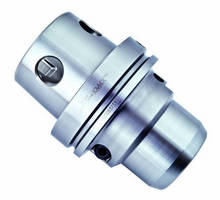
The spindle connection is the “handshake” -- the interface between the machine tool’s spindle and toolholder. As such, this vital component has to provide the torque and bending load capacity compatible with the machine-tool’s operating specifications. But when machining high-strength materials like titanium and other alloys, cutting forces generate bending moments that will exceed the interface’s limits prior to reaching the machine tool’s torque threshold. By combining high clamping force and optimized interference levels, Kennametal’s new KM4X100™ provides a robust connection, extremely high stiffness, and bending load capacity for greatly improved performance in machining high-strength alloys and other materials. The result is extremely high metal removal rates and more completed parts per shift.
“In most cases, the tool-spindle connection determines how much material can be removed on a given operation,” says Doug Ewald, director, global product management, tooling systems at Kennametal. “This is because this interface must withstand high loads and yet maintain its rigidity. With the ongoing advances in cutting tools and machining centers, a spindle connection like KM4X 100™ that makes the best utilization of available power possible is an important consideration to investigate early in production planning.”
Global Priority
High-strength, lightweight materials such as titanium alloys, Inconel, and new aluminium alloys are eagerly sought by manufacturers in many industries, including aerospace and defense, energy, and transportation. These new materials present significant machining challenges in themselves. Add the competitive pressures in these global industries, and finding advanced manufacturing solutions becomes a top priority. Machine-tool builders have responded with milling and turning centers that feature improved stiffness and damping on spindles and sizable machine structures and motors, all to provide the significant horsepower, torque and thrust forces required while minimizing undesirable vibrations that deteriorate part quality and tool life.
By using three-surface contact for improved stability and optimized clamping force distribution and interference fit, KM4X100™’s engineering results in three times the bending moment resistant capacity compared to other tool systems. This means:
-Shops can leverage KM4X-equipped high-performance machine tools to increase speeds and feeds in difficult machining applications, thus gaining the full productivity potential from the machine tool.
-Often, a smaller KM4X connection such as a KM4X100™ will provide the same or better cutting performance of a larger connection.
-KM4X systems can be applied on multi-tasking, turning, machining centers and transfer machines in manual, semiautomatic, or fully automatic mode.
“KM4X 100™ by design can perform in a wide range of operations, from low-speed/high torque to high-speed/low torque, allowing manufacturers to get the absolute most out of their production equipment,” Ewald says. ”Milling, drilling, and turning a wide range of materials just got more productive!” |